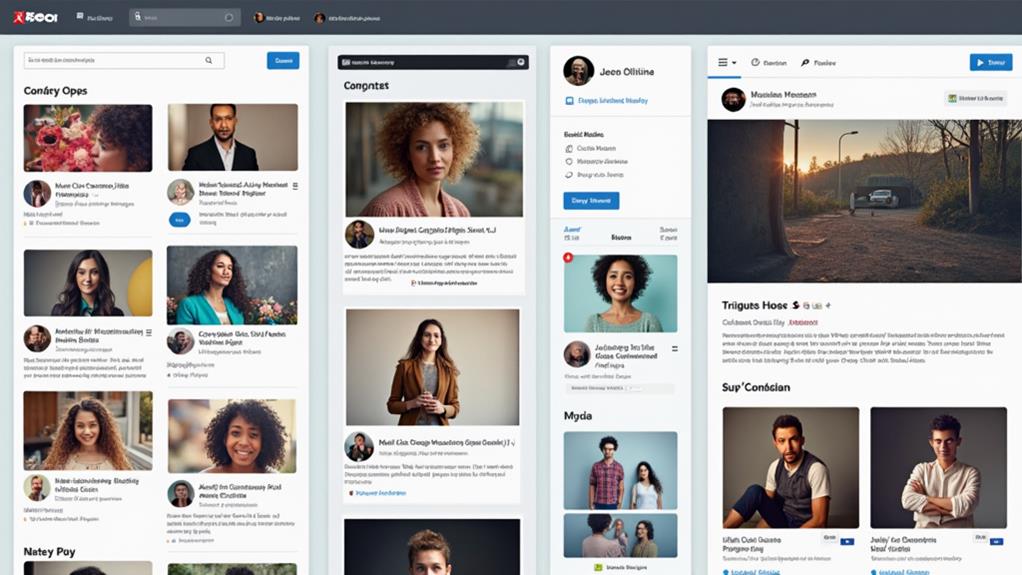User-generated content (UGC) plays an essential role in building brand trust and credibility by presenting genuine and relatable experiences. UGC is perceived as 2.5 times more authentic than traditional brand content, greatly impacting consumer behavior and trust. It enhances engagement rates and increases conversion potential by amplifying peer-driven endorsements through reviews, photos, and social media posts. Brands that integrate UGC often experience improved ad performance and heightened consumer trust, with 93% of consumers consulting online reviews before purchasing. Exploring strategies to leverage UGC effectively could reveal further potential in enhancing a brand's authenticity and consumer engagement.
Key Takeaways
- UGC is perceived as 2.5 times more authentic than brand-created content, significantly boosting consumer trust.
- 79% of consumers are influenced by UGC when making purchasing decisions, enhancing brand credibility.
- Sharing UGC across platforms increases engagement rates by 20%, amplifying brand visibility and trust.
- Positive UGC, such as reviews and testimonials, strengthens brand credibility, with 93% of consumers consulting them before purchasing.
- Encouraging authentic user participation through contests and hashtag campaigns builds community and brand loyalty.
Understanding User-Generated Content
User-Generated Content (UGC) has emerged as a cornerstone in the digital marketing landscape, offering a potent blend of authenticity and relatability that traditional brand-created content often lacks.
UGC benefits are profound, influencing consumer behavior and trust through various UGC types, including reviews, photos, videos, and social media posts. These forms of content authentically reflect consumer experiences and opinions about a brand, providing a genuine perspective that resonates with potential customers.
Statistics reveal that 79% of consumers acknowledge the significant impact of UGC on their purchasing decisions, underscoring its persuasive power in shaping brand perceptions. This influence is largely due to UGC being perceived as 2.5 times more authentic than content crafted by brands themselves.
The authenticity inherent in UGC fosters trust and credibility, essential components in today's competitive marketplace.
Moreover, positive UGC is a catalyst for enhancing brand credibility. With 93% of consumers consulting online reviews before purchasing, peer recommendations become invaluable assets for brands.
The strategic use of UGC can also lead to a 20% increase in engagement rates, illustrating its potential to cultivate deeper audience connections and drive consumer loyalty, ultimately bolstering a brand's market position.
Enhancing Brand Authenticity
In an era where consumer skepticism towards brand messaging is at an all-time high, the strategic deployment of user-generated content (UGC) emerges as a critical tool in enhancing brand authenticity. UGC is perceived as 2.5 times more authentic than brand-created content, considerably influencing consumer trust and purchasing decisions.
This authenticity is not just a perception but is quantifiable through authenticity metrics that show a 20% increase in engagement rates for brands effectively leveraging UGC strategies. By capitalizing on customer testimonials and real-life experiences, brands can create powerful endorsements that resonate with potential buyers, thereby enhancing their credibility.
The rise of social media platforms has further amplified the impact of UGC, allowing consumers to share their genuine experiences widely, consequently crafting a more relatable brand image.
With 79% of consumers reporting that UGC highly impacts their purchasing decisions, it becomes imperative for brands to integrate UGC strategies into their marketing efforts. This approach not only captures consumer attention but also fosters a sense of community and belonging among users, making the brand more relatable and authentic in the eyes of modern consumers.
Therefore, UGC serves as a cornerstone in establishing a credible and trustworthy brand presence.
Building Consumer Trust
A cornerstone of cultivating consumer trust lies in the strategic utilization of user-generated content (UGC), a medium that inherently carries the authenticity modern consumers crave.
With 93% of consumers reading online reviews before purchasing, UGC serves as a pivotal trust signal, shaping consumer perceptions and driving buying decisions. This peer-driven content, viewed as 2.5 times more authentic than brand-created counterparts, fortifies the bridge between consumer skepticism and brand credibility.
Brands leveraging UGC notice substantial improvements in ad performance, with 86% reporting enhanced results. This highlights the impact of authenticity in advertisements, where positive customer testimonials eclipse the influence of traditional paid promotions.
As consumers increasingly rely on real-life endorsements, the strategic deployment of UGC becomes indispensable in fostering consumer trust.
Moreover, the propensity of 77% of shoppers to purchase after encountering UGC underscores its power in enhancing consumer confidence. Through genuine experiences shared by peers, brands can effectively align with consumer perceptions, reinforcing their trustworthiness.
As brands continue to navigate the complexities of digital consumer engagement, UGC emerges as a critical tool, transforming authentic consumer voices into compelling narratives that resonate with potential customers.
Leveraging UGC Effectively
To leverage UGC effectively, brands should prioritize encouraging authentic user participation by fostering a sense of community through interactive social media campaigns and branded hashtags.
Amplifying this content across multiple platforms, including websites and email marketing, can greatly enhance engagement and conversion rates, as consumers are drawn to genuine experiences shared by peers.
Strategically engaging with users who contribute UGC not only strengthens emotional connections but also amplifies the brand's credibility and trustworthiness in the marketplace.
Encourage Authentic User Participation
Harnessing the power of authentic user participation is akin to unearthing a treasure trove of brand loyalty and trust. Implementing branded contests and hashtag campaigns can greatly amplify user engagement, drawing consumers into a dynamic narrative where their voices are heard and valued.
By establishing clear content guidelines, brands can guide users on how to effectively share their experiences, ensuring a diverse and genuine range of content that resonates deeply with potential customers. These participation strategies not only boost engagement but also contribute to community building, fostering a sense of belonging among participants.
To further enhance authenticity metrics, brands can implement reward incentives, encouraging users to produce valuable content that reflects personal experiences with the brand. This strategic approach creates a cycle of engagement, where users are motivated to continually participate, leading to sustained brand trust.
Actively engaging with user-generated content by liking, commenting, and sharing not only acknowledges user contributions but also strengthens brand-customer relationships. As studies show, 79% of consumers are influenced by UGC in their purchasing decisions, highlighting the critical role of authentic participation in elevating brand credibility and enhancing consumer relationships through strategic UGC initiatives.
Amplify UGC Across Platforms
Expanding on the foundation of authentic user participation, brands can greatly enhance their impact by effectively leveraging user-generated content (UGC) across multiple platforms.
Strategic platform strategies are vital in achieving content amplification, as brands that share UGC enjoy a 20% increase in engagement rates. By employing branded hashtags, companies can encourage users to share their experiences, fostering a vibrant community while boosting organic reach on visually-driven platforms like Instagram and TikTok.
To maximize UGC's potential, it's important to integrate it prominently within brand websites. Testimonials and customer photos not only enrich the site's content but considerably improve conversion rates by up to 77%, as authentic experiences guide potential customers in their purchasing decisions.
Moreover, incorporating UGC into email marketing campaigns can enhance engagement, with open rates increasing by 29% and click rates by 41%. This approach allows brands to connect more personally with their audience through relatable, user-focused content.
Collaborating with influencers for UGC amplification offers another potent strategy. Influencer content is perceived as 2.5 times more authentic than traditional brand-created content, considerably extending UGC's reach and enhancing overall brand credibility.
This multifaceted approach guarantees a dynamic, trust-building presence across platforms.
UGC in Digital Marketing
User-Generated Content (UGC) has emerged as a cornerstone in digital marketing, redefining the way brands build and sustain consumer trust. In an era where authenticity reigns supreme, UGC is perceived as 2.5 times more authentic than brand-created content. This perception is essential, as 79% of consumers report that UGC considerably influences their purchasing decisions.
To harness this potential, brands are increasingly adopting strategic UGC strategies, focusing on maximizing engagement and conversion rates through authentic customer interactions. One effective approach is leveraging UGC metrics to gauge engagement and effectiveness. Metrics such as engagement rates, which can increase by 20% when UGC is utilized, and conversion rates, which see notable improvement, offer invaluable insights into consumer behavior.
These metrics enable brands to refine their strategies, ensuring content resonates with target audiences. Moreover, integrating UGC into digital marketing not only enhances brand credibility but also aligns with consumer habits, as 93% of consumers read online reviews before purchasing.
Overcoming UGC Challenges
Steering through the complexities of user-generated content requires brands to strategically manage both quality and legal challenges to safeguard their reputation and authenticity.
Ensuring content quality is paramount, necessitating robust filtering systems to exclude inappropriate material while fostering genuine consumer engagement.
Simultaneously, brands must address legal issues, such as copyright and usage rights, by establishing clear guidelines and permissions to prevent disputes and maintain trust with their audience.
Ensuring Content Quality
Tackling the challenges of ensuring content quality in user-generated content (UGC) requires brands to adopt strategic moderation practices. Implementing robust content moderation and establishing clear user guidelines are essential steps in maintaining brand alignment and content integrity.
Brands that define submission criteria report a 70% improvement in content quality, underscoring the importance of setting expectations for contributors. To effectively manage UGC, leveraging curation tools and quality metrics allows brands to filter out inappropriate or off-brand submissions, ensuring that only high-quality content is showcased. This is vital, as 60% of consumers are deterred from purchasing due to low-quality content.
Engagement strategies play a pivotal role in community building. Regularly monitoring UGC and employing feedback mechanisms not only manage quality but also enhance brand-consumer relationships.
With 54% of consumers expecting timely responses to negative feedback, brands must prioritize interaction to maintain trust. Additionally, offering constructive feedback helps contributors improve, fostering a sense of community and loyalty.
Significantly, 65% of users report feeling more connected to brands that engage with their content. By incorporating these strategic practices, brands can enhance UGC quality, boost consumer engagement, and ultimately reinforce brand credibility and trust.
Navigating Legal Issues
As brands harness the power of user-generated content (UGC) to build trust and engagement, they must also address the legal intricacies that accompany this dynamic form of content.
Steering through the landscape of copyright compliance and user permissions is essential to avoiding potential disputes and maintaining brand integrity. Without clear legal frameworks, brands risk infringing on content ownership rights, which can lead to costly legal battles.
To effectively manage these challenges, brands should consider the following strategies:
- Obtain explicit user permissions: Before utilizing UGC, verify that users have clearly agreed to share their content. This step is vital for copyright compliance and safeguarding the brand from infringement claims.
- Define terms of service: Establish extensive content submission guidelines that outline ownership and usage rights, protecting both the brand and the creators.
- Monitor and moderate UGC: Implement a robust system to review and filter content, verifying that only appropriate and relevant UGC is featured, thereby minimizing legal risks.
- Consult legal experts: Stay informed about evolving copyright laws and UGC regulations by engaging with knowledgeable legal professionals, guaranteeing compliance and strategic decision-making.
Future Trends in UGC
Amidst the rapidly evolving landscape of digital marketing, several key trends are emerging in the domain of user-generated content (UGC) that promise to reshape brand-consumer interactions. Significantly, AI integration is revolutionizing how brands manage UGC. By streamlining curation processes, AI tools enable companies to analyze user content with greater precision, driving enhanced engagement. Meanwhile, a sustainability focus is increasingly prevalent. Brands are leveraging UGC that highlights ethical practices and eco-friendly initiatives, aligning with rising consumer demands and boosting trust.
Simultaneously, influencer collaborations remain a powerful strategy. Authentic UGC from influencers enhances credibility and relatability, essential elements in fostering consumer trust. This trend underscores the synergy between brand goals and the organic reach of influencer communities. Additionally, the fusion of UGC with augmented reality (AR) experiences is gaining traction. By crafting immersive interactions, AR empowers consumers to engage with products in innovative ways, enhancing experiential marketing.
| Trend | Impact |
|---|---|
| AI Integration | Streamlines UGC curation and analysis |
| Sustainability Focus | Enhances brand trust through ethical UGC |
| Influencer Collaborations | Boosts credibility and consumer trust |
| AR Experiences | Creates immersive brand-consumer interactions |
These trends underscore a strategic shift, positioning UGC as a dynamic tool in building brand trust and credibility.
Frequently Asked Questions
Why Is UGC Beneficial to Brands?
UGC strategies are beneficial to brands by enhancing consumer engagement and providing authentic endorsements. This authenticity boosts credibility, drives purchasing decisions, and improves ad performance, resulting in increased sales and fostering long-term brand loyalty and trust.
How Does UGC Build Trust?
User-generated content builds trust by showcasing authentic storytelling and genuine customer experiences, which resonate more with audiences than traditional marketing. This authenticity fosters a deeper connection, enhancing brand credibility and encouraging consumer trust and positive purchasing decisions.
What Is the Role of Brand Credibility?
Brand credibility plays a pivotal role in shaping brand perception and fostering consumer loyalty. It enhances consumer trust, influences purchasing decisions, and reduces price sensitivity, leading to increased sales performance and higher customer retention rates, ultimately benefiting the brand's longevity.
How Does User-Generated Content Boost the Credibility of a Business?
User-generated content enhances business credibility by offering authenticity signals through customer testimonials. This content is perceived as genuine by consumers, considerably influencing purchasing decisions and fostering a trustworthy brand image, therefore strategically boosting engagement and reputation.
Conclusion
User-generated content (UGC) serves as a vital tool in enhancing brand authenticity and building consumer trust. By effectively leveraging UGC, brands can create more genuine connections with their audience, fostering credibility in a digital marketing landscape. Despite challenges, strategic implementation of UGC can yield significant benefits, positioning brands favorably in the eyes of consumers. As digital trends continue to evolve, embracing UGC will remain essential for maintaining relevance and competitive advantage in the marketplace.




